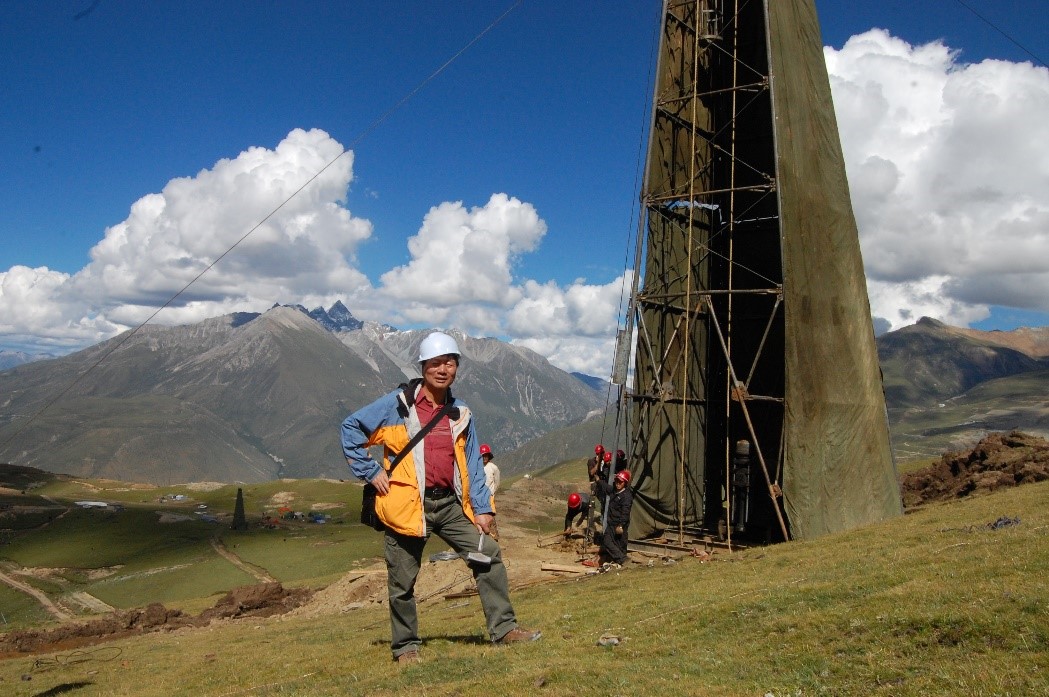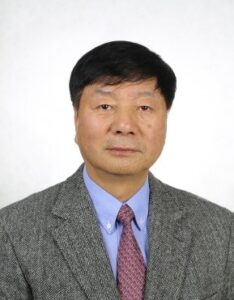
Ed Grew helps international team report jingsuiite, a new boron mineral from Tibet
Edward Grew, research professor in the School of Earth and Climate Sciences at the University of Maine, has helped a team of Chinese and Italian scientists obtain official recognition of a new boron mineral discovered as nano-inclusions in chromite deposits from a mine in Tibet. The new mineral has been approved by the Commission on New Minerals, Nomenclature and Classification of the International Mineralogical Association (IMA).
The manufactured compound titanium diboride, TiB2, is an extremely hard commercial ceramic. An unknown mineral with the same composition and crystal structure as the synthetic material was first reported in 2016 as inclusions in corundum (aluminum oxide) from volcanic ejecta from Mount Carmel, Israel. However, the authors did not attempt to propose it formally as a new mineral. Only the detailed laboratory study by the team involving Grew provided sufficient data to gain the much sought-after status as a new mineral approved by the IMA Commission.
Jingsuiite honors Professor Jingsui Yang of Nanjing University, an academician of the Chinese Academy of Sciences. Born in 1950 (like 2022, another “Year of the Tiger”), Yang received his PhD in 1992 at Dalhousie in Nova Scotia. He is a Fellow of the Mineralogical Society of America (MSA) and a Fellow of the Geological Society of America (GSA). He led the IGCP-649 project ‘Diamonds and Recycled Mantle’ in the International Geosciences Program sponsored by UNESCO and IUGS from 2015 to 2019.

Photo courtesy of Jingsui Yang
Prof. Yang expressed his great appreciation for the honor and reflected on the long history of research leading up to this discovery. He states, “so far, 15 new minerals along with diamond” have been discovered in the chromitites of the Luobusa ophiolites of Tibet. In the early years, there was much skepticism because these rare minerals were not expected to occur in ophiolites. In this regard, Prof. Yang observes that scientific debate about new finds will never stop, and he quotes T.H. Huxley: “Time, whose tooth gnaws away everything else, is powerless against truth.” (Collected Essays, 1894)
Jingsuiite is now the approved official name for the TiB2 mineral occurring in both Tibet and Israel, and it is the second boron mineral to be discovered in the Luobusa chromite ore. In 2014, Grew also contributed to the description of qingsongite, naturally occurring cubic boron nitride, BN, which as a synthetic material is another widely used abrasive marketed under the name “Borazon”.
In 2018, Ed Grew was invited to join the research team of Fahui Xiong, Xiangzhen Xu, and Paul T. Robinson in Beijing, China and Richard Wirth from the Helmholtz Center in Potsdam, Germany to characterize new minerals in the Luobusa chromite ore. In 2019, Enrico Mugnaioli and Mauro Gemmi from the Center for Nanotechnology of the Istituto Italiano di Tecnologia in Pisa, Italy were invited to join the team. Their application of 3-dimensional electron diffraction, a newly developed technology to decipher the crystal structure of grains no more than a few micrometers in size, carried the day – the crystal structure of TiB2 from Luobusa was finally solved, opening the way to eventual approval of jingsuiite as a new mineral.
“This collaboration has been tremendously exciting and very gratifying for me, especially at this stage of my career. Jingsuiite is my 6th new mineral from Tibet,” says Grew. “I am very grateful to my Chinese colleagues for inviting me to join them in this exciting work.”
Grew’s role in the description of qingsongite, jingsuiite and other new minerals in the Luobusa chromite ore has been to develop and guide the proposals for submission to the IMA Commission and the manuscripts for publication in international peer-reviewed journals, such as the European Journal of Mineralogy and the American Mineralogist. Jingsuiite has just been published in the January 2022 issue of American Mineralogist: “Jingsuiite, TiB2, a new mineral from the Cr-11 podiform chromitite orebody, Luobusa ophiolite, Tibet, China: Implications for recycling of boron” with Jingsui Yang’s former student Dr. Fahui Xiong as the lead author.
Ophiolites are slices of ocean crust and upper mantle that are incorporated in mountain belts when continents collide as a result of tectonic plate motion. One of the great ophiolite belts of the world is in Tibet, where the Indian subcontinent collided with the rest of Asia and pushed up the Himalaya Range. The surface expression of this boundary is the Yarlung-Zangbo Suture Zone south of Lhasa, Tibet, along which a series of ophiolites hosts the largest economic chromite deposits in China. The new minerals are interpreted to have formed in the Earth’s upper mantle by the action of mantle methane and hydrogen

